 |
 |
|
 |
 |
On January 15th (the 2nd by the old calendar) the Church commemorates the great Russian saint, the venerable Seraphim, wonderworker of Sarov.
|
|
St. Seraphim was born in the city of Kursk. His father, Isidor Moshnin, owned a bricklaying plant and accepted orders to build churches and houses. He and the saint’s mother Agafiya were very kind people, pious and loyal to God’s churches. On July 19, 1857 a second son was born to Isidor and Agafiya Moshnin. He was called Prokhor. At the age of three the little Prokhor became orphaned after the death of his father.
The widow Moshnina did not abandon her husband’s business and continued to build churches, including the one that later became the Kursk Cathedral of our Lady of Kazan. St. Seraphim’s mother personally oversaw the construction of the church. Once, when her second son was 7 years old, she went up to the very top of the belfry to look at the construction. Little Prokhor ran up to the edge and fell down to the ground from a great height. Great was the mother’s gratitude to God when she ran downstairs and found her son standing unharmed on the ground.
|
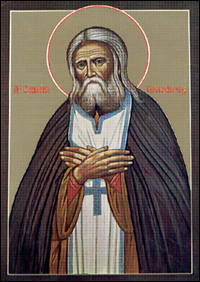
St. Seraphim of Sarov. |
|
There was another case of God’s special benevolence towards little Prokhor. Several years later he became very sick. His mother expected him to die, but fervently prayed to God to grant health to her son. And a miracle occurred: in his dreams little Prokhor saw the Mother of God, Who promised that he would be well. Several days later the miraculous icon of the Kursk Mother of God (which is now the Protectress of our Church Abroad) was carried in a procession along the street where the Moshnin house stood. Suddenly there was a downpour, and the people who were carrying the icon took a shortcut through the Moshnin estate. The mother carried out her sick son to the icon. The icon passed over the sick boy, and from that moment Prokhor began to get well and was soon in good health. Afterwards he embarked upon school studies. He studied well, and the reading of the Bible and church books gave him the greatest pleasure. He liked to go to church and did not miss a single service.
Prokhor’s older brother owned a store. They wanted to train young Prokhor for the trade too, but he begged his mother to let him go into a monastery. The pious mother agreed and, when saying farewell to him, blessed him with a large copper cross which he wore his entire life. Prokhor was 18 years old at that time. He was a very strong and healthy young man, quite tall, but meek and humble, had a straight nose, very expressive and penetrating light blue eyes, bushy eyebrows, and light blond hair.
Taking leave of his mother, Prokhor went off to Kiev to venerate the holy relics. Here a certain clairvoyant ascetic advised Prokhor to go to the Sarov hermitage and remain there for good. That is what Prokhor did. In 1770 Prokhor came down with a very grave illness. At that time he was already so respected for his ascetic life, that the monks and the abbot himself took care of him. They offered prayers for him in church, and he took Holy Communion. And after that he had a vision: the Most-holy Theotokos appeared to him together with the apostles Peter and John, touched his feet with Her staff, and placed Her hand on his head. Prokhor got well.
In 1786 Prokhor was tonsured with the name of Seraphim, which means “flaming,” and two months later he was ordained a hierodeacon. St. Seraphim’s spiritual feats of prayer were so great that the Lord visibly manifested His benevolence towards him. Once, during the first week of Great Lent, St. Seraphim saw a vision in church: the Lord Jesus Christ entered the church with a host of angels, blessed all who were praying, and then entered His icon on the iconostasis. The vision so astounded St. Seraphim that he became numb: he was rendered immobile and had to be led into the altar, where he stood in a stupor for two hours.
In 1793 St. Seraphim was ordained a hieromonk and soon received a blessing to live in solitude in a dense forest located approximately six kilometers from Sarov. The saint’s cell was a small, simple hut surrounded by a vegetable garden. For many years he lived in this desolate place, which was later called the outer hermitage. He wore the same clothes in winter and summer: a white linen coverall, leather mittens, bast sandals, and old kamelaukion (priest’s headgear) on his head, and his mother’s blessing – the copper cross – on his chest. Living in the forest, St. Seraphim prayed and labored continuously. Often he made a thousand prostrations. On Sundays and holidays he went to the monastery to take communion and sometimes conversed with the monks. His main instruction to them was concerning the need for constant prayer, either the Jesus prayer or the Theotokos prayer.
|
|
The saint’s life in the forest was very difficult. He suffered terrible temptations from the demons. In order to vanquish them St. Seraphim embarked upon the following endeavor for one thousand days and nights: during the day he stood on his knees on a large stone in his cell, while at night he stood on a large stone in the forest, and continuously said the Jesus prayer. Such an extreme feat of prayer caused severe suffering in his legs for the rest of his life. Evil persons increased the saint’s suffering even more. In 1804 he was attacked by three peasants who demanded money from him. St. Seraphim was very strong and could have easily repulsed the attack, but he did not defend himself. The villains hit him over the head with an axe, stomped on him with their feet, and beat him with a cudgel, then wreaked havoc on his cell, searching for money, but did not find anything except some icons and a few potatoes in the oven.
|
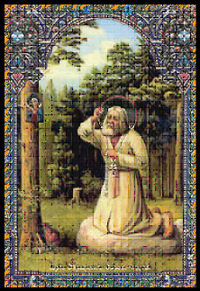
St. Seraphim prays on the rock. |
|
St. Seraphim, in a horrible state, was barely able to reach the monastery. His head was broken and his body was covered with terrible wounds. Physicians were immediately called to his side, but while they consulted over how to treat him, the saint had another vision: once again the Mother of God came to him with the apostles Peter and John. St. Seraphim then refused all medical aid and soon got well, although he remained forever hunchbacked. The villains who had beaten up the saint were soon found, but he forgave them and asked that they not be punished; however, the Lord Himself punished them: their huts and all their property burned down in a fire.
Some time later St. Seraphim returned to his deserted cell and took on a new spiritual labor – that of silence. He lived thus for three years. But then the monastery’s council of elders decided that the saint should come back to the monastery. St. Seraphim obeyed, but took on an even more difficult labor – that of total seclusion, never leaving his cell and never allowing anyone in. After the first five years of seclusion St. Seraphim began to open the doors of his cell, but did not speak to anyone, and only after the second five years he began to reply to questions and to talk to the monastery brethren.
In 1825 the Mother of God appeared to the saint in a vision and commanded him to leave his seclusion and to receive everyone. At that time the saint was 66 years old. During the next 7 years St. Seraphim received all who came to him and gave spiritual help to all, healing many people of illness. The saint had a daily quota of 2000 visitors, and on holidays there were 5000 and more. One can confidently say that during the last 7 years of his life, all of believing Russia visited St. Seraphim. With extra kindness the elder received those who wished to abandon their sinful lives, and gave them miraculous help. All people – rich and poor, noble and common – were received by the saint equally, while through his gift of clairvoyance he revealed to many people right away why they had come to him and what their need was. He greeted everyone with the words: “My joy, Christ is risen!”
|
|
Shortly before his death the saint once again saw a vision: the Mother of God came to him together with St. John the Baptist, St. John the Theologian, and several holy virgins. Blessing the elder, the Theotokos said to him: “Soon, My beloved one, you will be with us.” On January 1, 1833, on New Year’s day, the saint took communion and bid farewell to all the monks, while early in the morning of January 2nd the monks entered the saint’s cell and found him reposed. He was standing on his knees in a prayerful position, in his usual place before his favorite icon of the Mother of God, with his hands folded in the form of a cross and an expression of wondrous tranquility on his face.
|
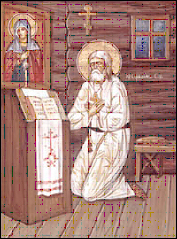
Repose of St. Seraphim. |
|
Remembrance of the wondrous elder spread throughout Russia. Crowds of pilgrims thronged to the Sarov monastery to his grave, and many received miraculous aid through prayers to St. Seraphim. On July 19, 1903 the great Saint Seraphim was glorified among the saints. The Tsar-Martyr Nicholas II and the Royal Family attended the festivities in honor of the saint’s glorification, and the Tsar personally carried the saint’s honorable coffin.
|
|
 |
The 100th anniversary of the glorification of Saint Seraphim of Sarov
(1903 – 2003) |
|
|
|
One hundred years have passed since that great day when finally took place the church glorification of “our joy” – the wondrous Father Seraphim, whom the Russian people regarded as a saint even in his lifetime.
People still remember those triumphant days in July, when the isolated Sarov hermitage temporarily turned into a crowded city, and thousands of pilgrims, not satisfied even with the lengthy church services, rapturously sang church hymns all through the night. The pious Tsar-Martyr Nicholas II himself, together with his entire august family, led this truly national celebration, and it was not surprising that in the wondrous night of 18th to 19th July, no one in the multi-thousand crowd that had settled around the hermitage could sleep, while the singing included even paschal songs. All of this, as was later remembered, was the fulfillment of the words of the elder, who had said to one of the Diveevo nuns before his repose: “What great joy there will be! In the middle of summer they will sing Pascha, my joy! The Tsar and his whole family will come to us!”
|
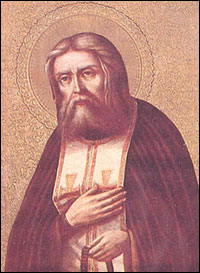
St. Seraphim of Sarov |
|
One hundred and seventy years have passed since the blessed repose of this greatest ascetic of our times. A period of time that is long enough for the memory of a mortal man who lived so long ago to pass into oblivion. How many people have been born and have died in this time, and no one remembers them with a kind word safe their kinsmen, and even they often forget to pray for the souls of the deceased.
But this happens only with those people who place the entire joy and happiness of their lives in earthly pleasures, who throughout their brief earthly life think only of how to spend time more comfortably and more pleasantly.
Those who renounce themselves for the sake of Christ and take upon their shoulders the Cross of Christ, who willingly crucify themselves to the world, who suppress their flesh – that unruly and willful slave, in order to live in Christ and for Christ, regarding all as dust for the sake of Christ, - such men live eternally and their memory remains unto the ages of ages. “The memory of the righteous shall be eternal,” – sings the Church about such people, - and shall not be affrighted by evil rumor.”
The memory of such righteous people as Saint Seraphim not only does not fade with the passage of time, but becomes stronger and more exalted. To many of us “Father Seraphim” is, perhaps, even closer and more precious than he was to his contemporaries. His bright image shines before us as a guiding light into the Heavenly Realm. As we think about this and pray to him, we can sense the reflection of the majestic glory with which, after his repose, the Lord imbued him in the celestial dwellings.
And this is not in the least surprising. The saint’s entire life offers us a highly instructive example of true Christian asceticism, sincere and ardent faith, and fiery love for God and one’s neighbors. This fieriness is his most prominent characteristic, for which, in monasticism, he was providentially given the name Seraphim (which means “fiery”), and which is lacking most of all among modern Christians, who are being spiritually destroyed by their lukewarmness. “I am come to send fire on the earth,” – says the Lord Jesus Christ, - “and how I wish that it be already kindled” (Luke 12:49). The holy fathers understand this “fire” to be the fire of divine ardor, the fiery zeal of pleasing God, without which genuine spiritual life is impossible. It was this fiery zeal for pleasing God which Saint Seraphim had in abundance, and it glorified him to such a degree that he, who lived close to our times, became in spiritual status the equal of the great Christian fathers of ancient times, and left a blessed memory of himself.
Celebrating the centennial of the glorification of our wondrous saint, let us pray to him especially to obtain for us, contemporary lukewarm Christians, this fiery zeal for pleasing God. Let us also remember the deeply-moving testament which he left to the nuns of Diveevo, and through them - to all of us:
“When I am gone, come to my grave, come whenever you have time, the more often the better. Everything you have on your mind, everything over which you sorrow, everything that may have happened to you, - come to my grave and tell me all about it, as though I were alive, and I will hear you, and your sorrow shall pass! Speak to me as to a living person, and I will always be alive for you.”
Nowadays, when all of us experience so many sorrows, when we are living in the terrible times which Saint Seraphim foresaw and foretold, it behooves us more than ever to remember his testament. No matter that we are deprived of the sweet opportunity to actually fall upon the grave of St. Seraphim, in order to weep out our sorrow; let us not be upset by it – the great saint will hear us nevertheless, so long as we warmly pray to him with sincere faith and tenderness of heart:
“O venerable Seraphim, pray for those who with faith and love revere Thy holy memory!”
Archbishop Averky (Taushev)
|

|
From the life of Saint Seraphim
|
Two nuns from a certain convent once came to visit Saint Seraphim. Suddenly a bear lumbered unexpectedly out of the woods and frightened the visitors with his appearance. “Misha,” – said the saint, - “why do you frighten the poor orphans! Go back and bring us a treat, otherwise I have nothing to offer to my guests.” Hearing these words, the bear went back into the woods, and two hours later he tumbled into the holy elder’s cell and gave him something covered with leaves. It was a fresh honeycomb of purest honey. Father Seraphim took a piece of bread from his bag, gave it to the bear, pointed to the door – and the bear left immediately.
If we had lived in the saint’s times, if we had gone to the Sarov hermitage, visited the saint’s solitary abode, we would have met there the holy elder with his face shining like the face of an angel. In the summer we would have seen him in white clothes – a coverall made of sackcloth. On his chest he wore a copper cross, - the same cross with which his mother blessed him when, as a youth, he set out for Kiev. In the winter he wore a coat and mittens.
|
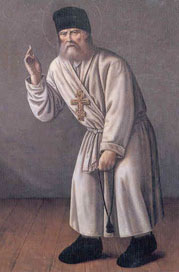
St. Seraphim in his customary
clothes |
|
If we were to go to the Sarov hermitage, we would have bathed in the holy spring. The Queen of Heaven Herself, together with John the Theologian and the Apostle Peter, appeared to the holy elder, struck the ground with Her staff – and from the ground sprang a stream of the purest cold water, and afterwards many sick people, having bathed in this water, were cured.
|
|
Once, in the deep thicket of a pine woods, the saint found a large rock. He then embarked upon a God-pleasing spiritual feat similar to those undertaken by ancient holy people: for one thousand days and one thousand nights, with his arms raised up to heaven, the great saint prayed to God with tears of spiritual tenderness. Day and night he whispered a single prayer: “O God, have mercy upon me, a sinner.” Throughout the winter nights, in the darkness of night, the saint stood on the rock, all alone in the thick dark woods. We would have been afraid of wild animals, and evil people, and the cold, and the wind, but Father Seraphim feared nothing – the Lord and His angels were with him. The saint’s legs began to hurt from his long stay on the rock, and he was forced to return to the Sarov hermitage, where he lived in a small, solitary cell. In the corner hung an icon of the Mother of God “Tenderness,” before which a lampada always burned. The cell did not have a bed. The saint spent the night in prayer and did not sleep on soft beds as all of us, sinners, do. When he was overcome by sleep, he lay down on the floor and dozed off for a brief while. For his great spiritual feats the Lord showed him the incredible beauty and wonder of paradise even while he was living on earth.
|

St. Seraphim prays on the rock |
|
The saint’s fame spread through all of Russia, and people began to come from afar, just to see and talk with the great elder. Father Seraphim welcomed everyone with joy and love. He greeted people merrily and affectionately, but instead of “hello” he would say “Christ is risen!” In the saint’s heart there was always joy, always Pascha, because he loved the Lord with all the purity of his heart.
St. Seraphim was especially tender and affectionate with children. One time a little girl, Nadya Aksakova, visited the saint together with her parents, and when she grew up, she recorded her meeting with him. When Nadya and her family came to the saint’s cell, he wasn’t there, but had gone into the woods to pray. Nadya and her parents, together with some other children, went to look for him in the pine woods. The children went ahead, while the parents and other pilgrims followed. Here is how Nadya herself describes the meeting: “The woods became thicker and blacker. Under the high arches of huge pines it became completely dark. The gloomy woods seemed terrifying. Luckily somewhere in the distance a ray of sun gleamed through the needled branches. We perked up, ran towards the light, and soon came to a green sunlit meadow . We looked – and there, near the roots of a pine tree, a small and thin old man was working, all bent down to the ground, deftly cutting the grass with his axe. Hearing a rustle in the woods, the old man quickly got up, quickly ran into the thicket and disappeared from our view. We all cried out in unison: “Father Seraphim! Father Seraphim!” Hearing the voices of children not far from him, Father Seraphim could not remain in his hiding place, and soon his head appeared over the high blades of the woodland grass. Placing a finger on his lips, he gazed upon us tenderly, as though entreating the children not to reveal his presence to the adults, and then, lowering himself onto the grass, he beckoned us to him. Our little one, Liza, was the first to throw herself around the old man’s neck, pressing her soft face against his shoulder, which was covered by sackcloth. “My treasures, my treasures,” – he whispered softly, pressing each one of us to his thin chest. On the way back from his cell, little Liza, whom Father Seraphim had embraced first, came up to me and said: “Father Seraphim only appears to be an old man, but in reality he is a child like you and I, isn’t he, Nadya?”
|

St. Seraphim lovingly greets the children |
|
Shortly before his blessed repose, the great saint was visited by the Queen of Heaven, Who told him about his imminent departure from the sinful earth. An old Diveevo nun by the name of Eupraxia was in the elder’s cell when he was visited by the Mother of God, and later told others about this wondrous celestial vision.
|
|
It was very, very quiet in the cell. The saint was praying, when suddenly a fresh fragrant breeze wafted in, the singing of angels was heard, the door of the cell opened by itself, the cell was filled with bright light. At first the angels with golden flaxen hair came in, carrying blossoming branches from paradise in their hands. They were followed by St. John the Baptist and St. John the Theologian, and after them, shining with an extraordinary, unearthly brightness, came the Queen of Heaven, accompanied by twelve virgins. The Mother of God wore a green-colored robe, on Her head there was a brightly shining crown, and Her hair was more beautiful and longer than the angels’. She was taller than all the holy virgins. The Queen of Heaven spoke with the holy elder at great length, and before Her departure told him that he would soon be with the Lord.
Soon after the feast of Christ’s Nativity, on January 2, 1833, the soul of the righteous one departed from this sinful earth for God’s paradise. Before his repose the holy elder sang paschal hymns. He died while praying on his knees before his beloved icon of the Mother of God “Tenderness,” leaving the world of tears for a world of eternal joy.
|
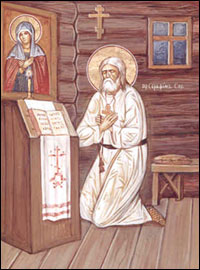
The blessed repose of St. Seraphim |
|
|
|
|
|
|
 |